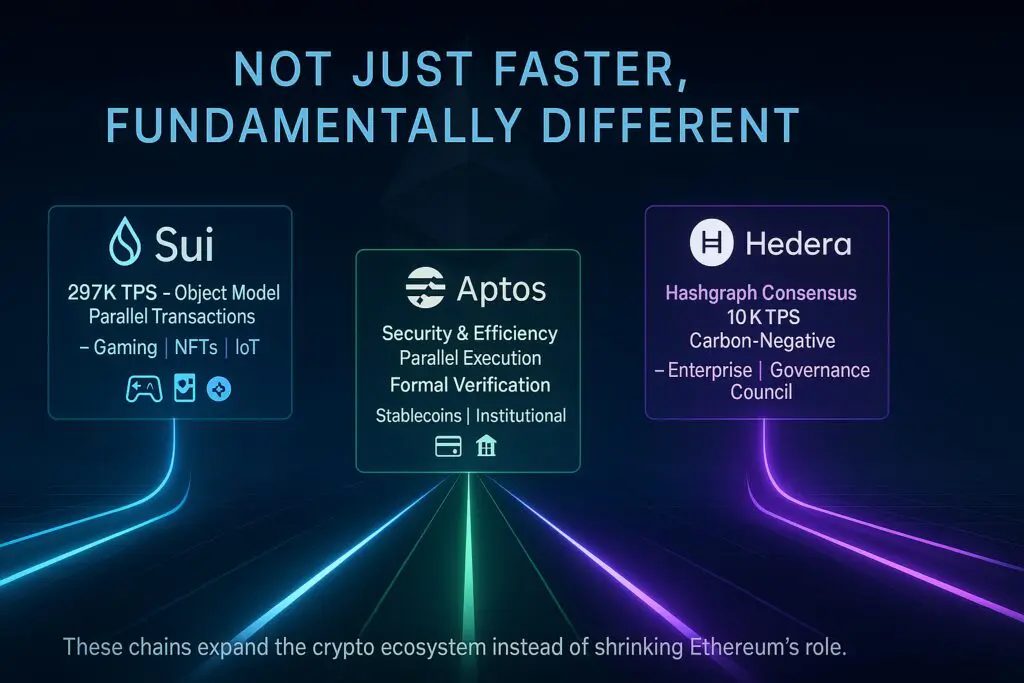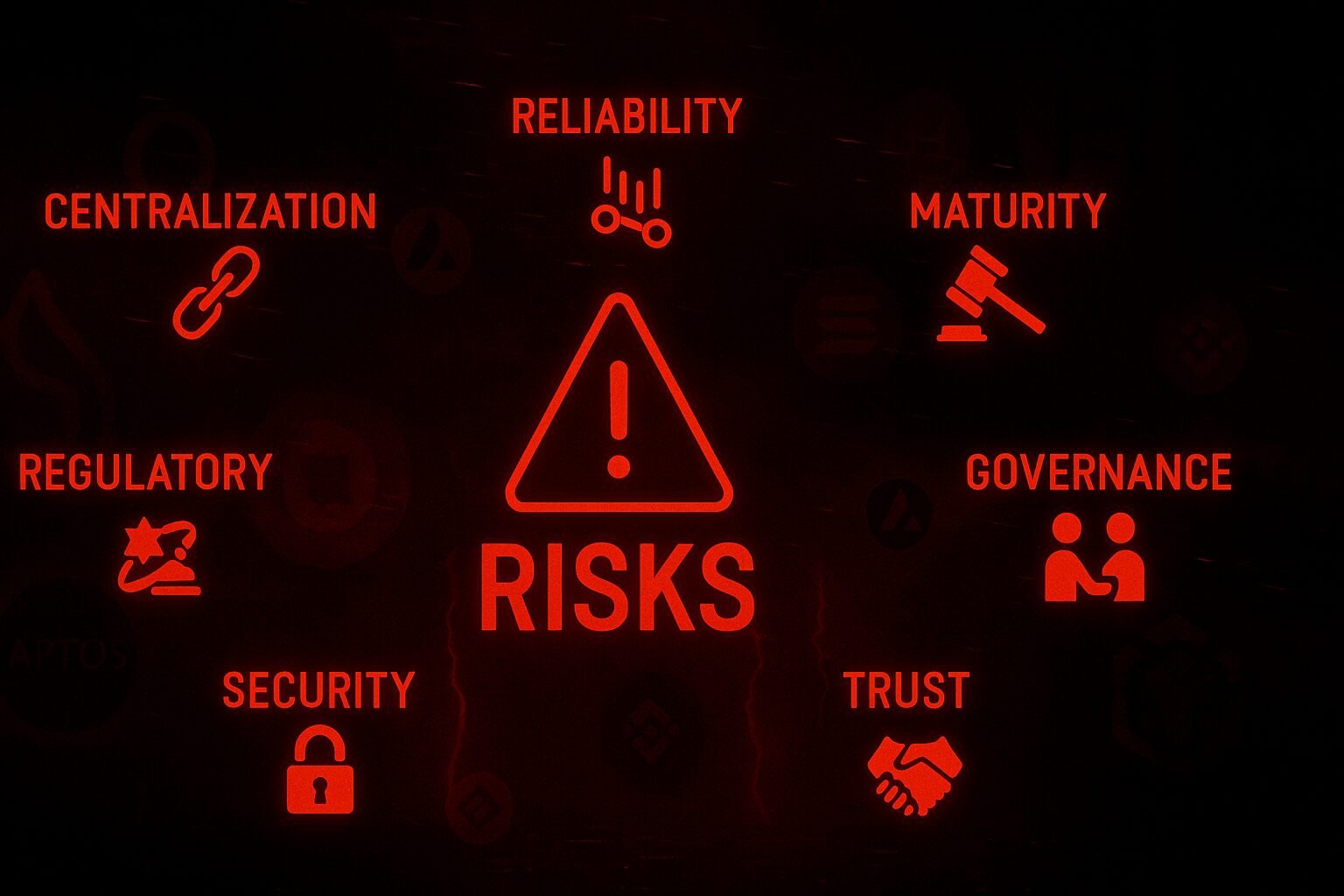
Ethereum dominates blockchain, but can altcoins like Solana, Sui, and Avalanche compete in the long run? Explore Ethereum vs Layer 1 Altcoins
Author: Chirag Sharma
Published On: Sat, 23 Aug 2025 20:54:18 GMT
Since 2015, Ethereum has been the go-to Layer 1 blockchain, fueling the rise of DeFi, NFTs, and smart contracts. With a market cap often exceeding $300 billion and a developer base in the millions, it looks untouchable. But cracks have appeared. High gas fees, network congestion, and limited throughput have given room for other players to challenge its throne setting a good plot for Ethereum vs Layer 1 Altcoins
The Merge in 2022 was historic, shifting Ethereum to Proof of Stake, but transaction costs of $2–5 during peak periods remain a barrier. Even with Layer 2 solutions, Ethereum struggles to scale fast enough for global adoption. This is where the new generation of Layer 1 altcoins comes in, claiming to fix what Ethereum hasn’t.

The big question: can these networks genuinely compete, or are they destined to complement Ethereum instead of replacing it?
Ethereum processes around 15–30 transactions per second at its base layer. Rollups and scaling solutions push this higher, but speed remains a sticking point. Compare this to Solana, Avalanche, or Aptos, which boast thousands of transactions per second with lower fees.
Ethereum still wins in developer mindshare and dApps, with over 4,000 active projects. Yet challengers are finding niches where they shine: Solana in real-time trading and gaming, Avalanche in institutional tokenization, Hedera in enterprise solutions, and BNB Chain in mass adoption.
Here’s how Ethereum stacks up against its rivals in 2025:
| Network | TPS (approx) | Avg Fees | Main Strength |
|---|---|---|---|
| Ethereum | 15–30 (1000s with L2) | $2–5 | Security, ecosystem, decentralization |
| Solana | Up to 65,000 | <$0.01 | High speed, gaming, DeFi |
| Avalanche | 4,500 per subnet | <$0.05 | Institutional tokenization, custom subnets |
| Sui | Up to 297,000 | <$0.01 | Gaming, parallel execution |
| Aptos | 160,000 (tests) | <$0.01 | Stablecoins, DeFi, safety |
| Hedera | 10,000 | <$0.01 | Enterprise trust, compliance |
| BNB Chain | 5,000+ | <$0.05 | Mass adoption, CEX integration |
Solana has become the go-to chain for high-volume DeFi and gaming. Its Proof of History consensus enables sub-second transaction times and fees under a cent. In 2025, Solana’s ecosystem exploded with over 10,000 hackathon projects and institutional adoption. Its Firedancer upgrade also boosted validator performance, making it more reliable for future scaling.
Avalanche, meanwhile, takes a different route. Its subnet architecture allows enterprises to build custom blockchains with specific rules and compliance layers. FIFA’s NFT platform migrated to Avalanche, and institutions like SkyBridge Capital used it for tokenized funds. Daily transactions surged nearly 500% in Q2 2025, showing real-world demand.
These networks prove that Ethereum is not the only option anymore. However, while Solana and Avalanche beat Ethereum in raw speed, they haven’t matched Ethereum’s decentralization or security depth. That’s why it feels less like replacement and more like healthy competition.
Some Layer 1 altcoins aren’t just faster, they’re fundamentally different.

These chains are not trying to be Ethereum clones. They are carving unique lanes where Ethereum is less effective. And in doing so, they expand the overall crypto ecosystem rather than shrink Ethereum’s role.
If Solana and Avalanche dominate speed, and Sui or Hedera cover niches, then BNB Chain plays another card: mass adoption. Backed by Binance, it seamlessly connects centralized liquidity with decentralized activity. With near-instant transactions and fees under $0.05, it’s a go-to for users moving from exchanges into DeFi.
In Q2 2025, BNB Chain processed nearly 10 million daily transactions and locked $92 billion in TVL. Its roadmap includes gas limit increases to handle billions of users and AI-driven upgrades for easier user experience.
Here’s how adoption metrics compare across ecosystems:
| Network | Daily Active Users | Daily Transactions | TVL (approx) |
|---|---|---|---|
| Ethereum | ~2.2M | ~1.5M | $110B |
| Solana | 2M+ | ~40M | $5B |
| Avalanche | 1.2M | ~15M | $8B |
| Aptos | 10M users total | ~5M | $2.5B |
| Sui | 500k+ | ~2M | $1.8B |
| Hedera | 400k+ | ~3M | $2B |
| BNB Chain | 3M+ | ~9.9M | $92B |
It’s tempting to look at the flashy transaction speeds or ultra-low fees of Layer 1 altcoins and think they’ve solved Ethereum’s problems. But dig a little deeper and you’ll find that most of these chains face challenges of their own. These risks are why the Ethereum vs Layer 1 Altcoins debate is more complex than simply comparing numbers.

1. Centralization Trade-offs
Ethereum’s decentralization is its greatest strength. Thousands of validators worldwide secure the network, making it resistant to manipulation. Compare this with altcoins like BNB Chain, which is closely tied to Binance. While that connection brings liquidity and adoption, it also means heavy reliance on a single corporation.
2. Technical Reliability
Solana, despite being one of the fastest blockchains, has a history of network outages. These halts may last hours and undermine user confidence. Speed is great, but if a chain goes down during peak trading or gaming activity, the damage to credibility is massive. Ethereum, for all its flaws, has proven battle-tested stability over nearly a decade of operation. That level of reliability is not easy to replicate.
3. Ecosystem Maturity
Ethereum boasts more than 4,000 dApps and millions of developers. In contrast, newer chains like Sui and Aptos are still growing their ecosystems. They might process transactions faster, but without robust developer adoption, the apps and tools users expect may take years to mature.
4. Regulatory and Governance Pressures
Hedera positions itself as enterprise-friendly with its council governance model, including giants like Google and IBM. But that very structure could slow it down. As global regulations evolve, governance-heavy models may become more constrained.
5. Security and Trust
Finally, speed often comes at the cost of security. Ethereum has withstood countless hacks and attacks, yet remains resilient. Many altcoins are newer, untested at scale, and could face vulnerabilities when billions in value are locked on their networks.
The bottom line: Layer 1 altcoins are exciting, but they come with trade-offs. Until they prove the same level of stability, security, and decentralization as Ethereum, their role will likely remain complementary rather than dominant.
So, can Layer 1 altcoins compete with Ethereum in the long run? The answer is yes, but not in the way many expect.
Ethereum remains the secure base layer and the most decentralized option. But Layer 1 altcoins are excelling in niches: Solana for speed, Avalanche for subnets, Sui and Aptos for developer-friendly architectures, Hedera for enterprise-grade compliance, and BNB Chain for mass adoption.
This is less about one chain winning and more about a multi-chain future. Interoperability protocols like Wormhole and LayerZero are already linking ecosystems together. Rather than undermining Ethereum, these altcoins push it to keep upgrading. Ethereum’s Pectra and Fusaka upgrades aim for 100,000+ TPS, proving that competition fuels innovation.
The risks remain: Solana’s outages, BNB’s centralization, and Ethereum’s scaling delays could all cause setbacks. But overall, this diverse environment decentralizes power, spreads risk, and accelerates global adoption.
In the end, Ethereum vs Layer 1 Altcoins is not a zero-sum battle. It’s the foundation of a healthier, more resilient crypto industry that can scale to billions of users in the years ahead.
1. Why is Ethereum considered the leader among Layer 1 blockchains?
Ethereum dominates because of its security, decentralization, and the largest ecosystem of developers and dApps, making it the most trusted base layer.
2. What are Layer 1 altcoins?
Layer 1 altcoins are independent blockchains like Solana, Avalanche, and Sui that compete directly with Ethereum by offering faster transactions, lower fees, or specialized features.
3. Can Layer 1 altcoins replace Ethereum completely?
Unlikely. Ethereum is too entrenched, but altcoins can complement it by handling niche use cases such as gaming, enterprise solutions, or mass adoption.
4. Which Layer 1 altcoin is the fastest?
In 2025, Sui has demonstrated up to 297,000 transactions per second in tests, making it one of the fastest L1s.
5. How does Solana compare to Ethereum?
Solana is much faster and cheaper but less decentralized. Ethereum remains more secure and has the most developer activity.
6. Why is BNB Chain important in the Layer 1 debate?
BNB Chain connects centralized exchange liquidity with decentralized applications, making it ideal for onboarding millions of users.
7. What upgrades are coming for Ethereum?
Ethereum’s 2025 roadmap includes Pectra (validator efficiency) and Fusaka (blob storage and 100,000+ TPS scaling) to improve scalability and security.
8. What is the future of Ethereum vs Layer 1 altcoins?
The future is multi-chain: Ethereum as the secure hub, with altcoins excelling in speed, enterprise, or adoption. Together they expand the crypto industry.

